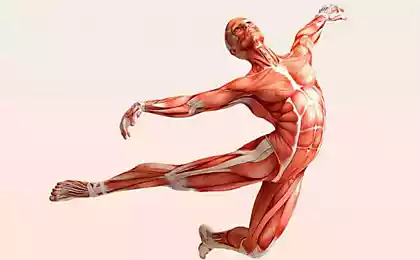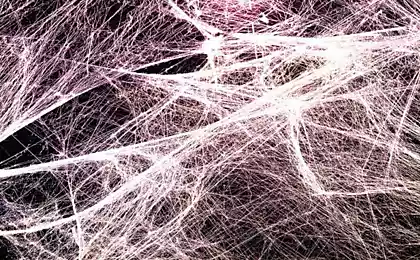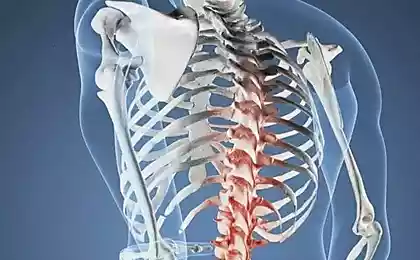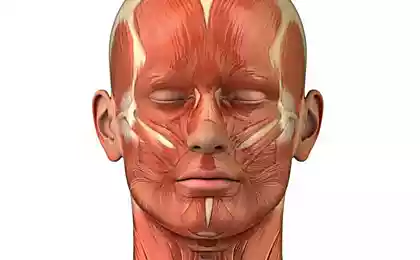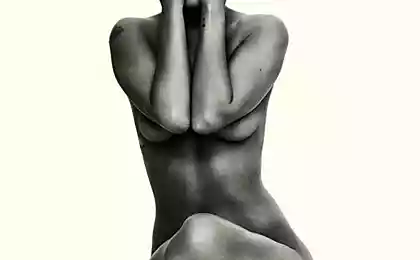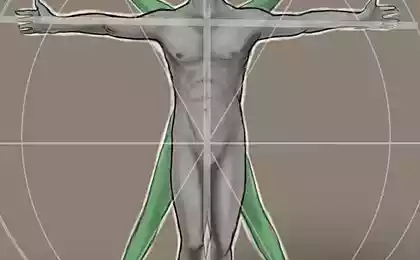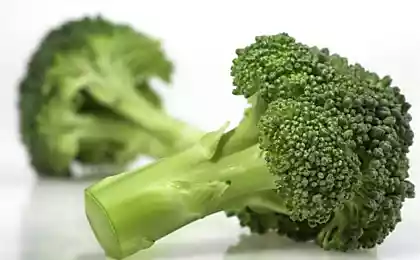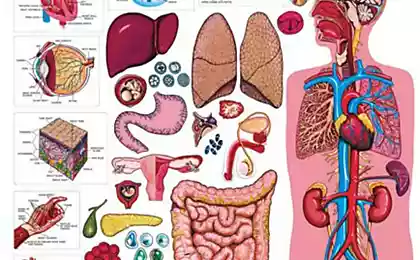751
Unknown "body inside body": the cause of unexplained diseases and syndromes
Connective tissue permeate the entire body. For a long time it was believed that the plexus of fascia, ligaments and tendons perform only auxiliary functions. Only now scientists are beginning to appreciate their influence on health and well-being. And to understand why massage, acupuncture and yoga help to get rid of the pain.
Stekko Carl, Professor of anatomy, University of Padova (Italy), made no secret of irony, when he hears from some arrogant doctors, as if all the secrets of the human body are already revealed. She knows that it is not. Recently Carla and her colleagues from other countries made a breakthrough in modern medicine, "opening" in the human body is a huge system that until recently was virtually unknown.
This unexplored "body inside body" — connective tissue, which most people associate with signs of aging: wrinkles, folds, cellulite. And suddenly these strange white fibers, called fascia, turned out to be the center of attention. They recognized not only the cause of many more recently, unexplained diseases and syndromes, but also a source of healing power.
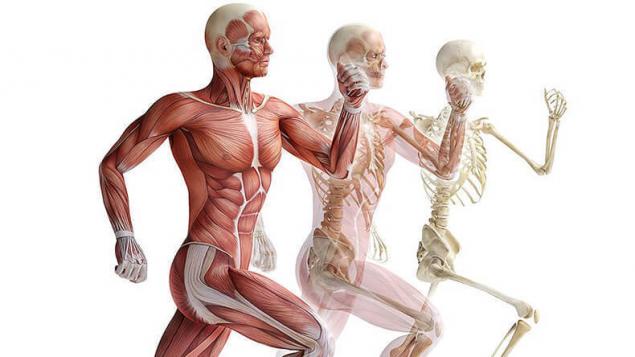
Experts called fascia the "communication network of the body", "infrastructure of life" and "Wellness". In medicine there is a revolution.
The idea that the main support of the body — solid bone skeleton, which if necessary can "fix" the chiropractor, is obsolete in my eyes. It is replaced by a dynamic model, sliding elements, United by a pervasive network of fascia. This is the real skeleton of the body, which is bone, muscle, and everything else.
Moreover, interactions of the connective tissue lies a clue to the effectiveness of many alternative treatments, which for a long time was not recognized by official science: yoga, acupuncture, massage and osteopathy. It seems that in the history of medicine opens a new Chapter.
Pain syndromes are common disease. A good half of office workers are well aware of the "unexplained" back pain and shoulders. Even with the most modern equipment, doctors can identify the causes of the pain syndrome only 20% of cases. The remaining sufferers have to be content with vague reasoning physicians about psychosomatics, age, wear and tear of the joints, arthritis...
"Many doctors really believe that all the most important thing about the structure of the human body they know," says Carl Stekko in the anatomical theatre of Padua University. Dissecting corpses, pathologists still just separate the fascia from the organs and muscles and cast aside like garbage. Karl also talks to his students about connective tissue almost with tenderness.
"Here it is, see here and here, Professor Karl Stekko leaning over the exposed body. — Connective tissue is present everywhere. Not only in skin, but in tendons, muscles and cartilage. It is a delicate web ensnares the human body from head to toe, inside and out. Coats and lines all the internal organs, intestines, heart, eyes, liver, blood vessels and even the brain."
Carla, having straightened up, turned to the audience: "If we remove from this body, except connective tissue, it will completely retain its shape. We will get leathery shell bodies, which will remain in place and will not change size. It is possible even to determine the sex of a person. In other words, within every body is his exact copy."
Stekko again plunges the scalpel into prepariamo body. Skin with two layers of connective tissue are already dismembered. Skillful movements of Charles separates fragments of fascia and raises them to the light. White, grayish, beige adhesive film with a pink hue, with yellowish patches of fat cells or the blue network of blood vessels. She gently separates the gleaming wet plate thickness in mm. Probes tangles the finest fibers. Stretches for clarity, stubborn strands of tendons. And gently stroked the tender layer — soft, like jelly.
Have connective tissue many forms and types. First of all, this "loose connective tissue". Something like a sticky grease between the individual layers, plates, muscles and organs, which ensures unimpeded mutual sliding of all parts of the body during movement.
"How can she serve as a support and the cover material? — appeals of Charles Stekko to students. — No, nature would never create such a complex and large-scale system, then the connective tissue more important tasks."
Often it is difficult to understand where the end of the internal organs and starts connective tissue. This global web encircling the whole body, has no beginning and no end. It envelops and permeates muscles, allowing for flexible interaction of all elements of the muscles. And it's not just the "packaging film". Fascia surround every cell, forming within the muscle tissue cellular structure.
"Connective tissue, continues his lecture Stekko is also a huge sensory organ". More than 80 percent of the free nerve endings are concentrated in the fascia separating muscle motor apparatus from the subcutaneous tissue. The network is replete with movement and pain receptors. And provides including the ability to "proprioception" — the sense of position of parts of the body relative to each other in space. Thanks man and animals consistently move the limbs, without passing through the minds of each movement separately.
"And like all human organs, connective tissue can be damaged and hurt," says Stekko.
In the classroom silence. Charles shows students a wide thick plate in the form of a perfectly symmetrical diamond pattern. Fascia thoracolumbalis three — layer thoracolumbar fascia, the most powerful in the body. It is thickly covered with highly sensitive receptors. Stekko believes that this fascia often becomes the main cause of "unexplained" back pain.
"We don't yet have a full picture of the disease of fascia," admits Stekko. But it is clear that back pain in many cases caused by the friction of the three layers of the lumbar fascia in mutual sliding. This is confirmed by the results of ultrasonic studies conducted by American doctors. They found in patients with diseases of the spine a weakness in the fascial tissues.
A new theory of pain States that: the cause of the pain it breeds not only in the muscles and joints, as was considered before, but in the loose connective tissue, which serves as a lubricant between the fascial layers. The proponents of this theory believe that it is in the connective tissue changes occur, which at the slightest stretching of a muscle irritated pain receptors.
"Try rubbing two smooth silk handkerchief, and two pieces of coarse canvas, and you will immediately understand what it means to the friction between the layers of connective tissue," explains Stekko. The goal of therapy is to restore the smooth gliding of the fascia.
"Amazingly, the surgeons during operations almost without thinking cut up with a scalpel most important the fascia", — she laments. Such internal injuries often do not heal well due to their place by dangerous spikes, which can cause illness many years later. Internal scars similar to the barriers of the connective tissue.
Robert Sleepw managed to overcome a lot of barriers to go from the esoteric-Amateur to graduate psychologist and expert on "Rolfing" — a deep massage, especially connective tissues. Literally with his bare hands he cured many patients with pain syndromes. But it could not answer the question: what exactly happens to the human body when such treatment? In search of the answer Sleep he turned to a University laboratory in the German Ulm.
And in 2006, Sleip, which was then already 51 years old, received the award and a brief annotation in the prestigious scientific journal "science" for his doctoral thesis. The researcher stretched the fragments of fascial fibers in the invented apparatus and treated them with hormones, which secretes the body in time of stress. And it turned out that in most cases, the tissues react to the effects of a slow but sure grip. So, the connective tissue under stress may be reduced regardless of the muscles.
"Systems analysts" — the so-called Sleep themselves and their colleagues. They are not only doing laboratory research, but also every two years in Ulm gather experts from around the world at the summer seminar on the fascia. The main theme of this seminar: is there any tension on the fascia from one part of the body to the other?
"For example, I move the hand. Does it affect my leg? — drawn Sleep to the participants for clarity, waving his hand. And answers himself. — Yes, because mechanical stress is transmitted across the entire network of fascia. It can be compared to elastic tights, tight body. If you delay it at the top, the tension will be felt below. The Domino effect inside the body".
That's why the slight dislocations of the knee joint can cause back pain and excessive strain on the Achilles tendon to the formation of heel spurs. Feeling the pain, people reflexively accept the "gentle posture" which at this point alleviates the discomfort. But in the long run only exacerbates the problem.
Aging is not the only reason the fascia lose their elasticity. In most cases, the cause of the pain become invisible pinholes: tiny cracks and wounds.
For example, a light injury received in a car accident. Or chronic load during prolonged work at the table. Usually the little things no one pays attention. But the stress accumulates day by day. And at some point, often after years of damage, connective tissue can not withstand. So microtrauma transformed into hotbeds of pain.
However, connective tissue injure not only of excessive stress (e.g. intensive sport), but physical inactivity: physical inactivity, prolonged bed rest, the wearing plaster casts for hands and legs.
In addition, detrimental to the fascia stress, sun exposure and poor diet. Inflammation of the fascia can cause postoperative scars. If it spreads to the adjacent muscles, the hardening of the tissues narrows the space around the nerve fibers passing through the fascia. The result is tension and pain.
And it's not only about the syndromes of type "frozen shoulder" — so the doctors call malaise, known to many office workers who have long hours sitting hunched over a Desk.
There is a suspicion that the varicose vessels, and grinding of teeth at night, and intestine disorders, and pulmonary disorders, and pain in the hip and knee joints is also caused by damage to the connective tissue. And rheumatism of soft tissues and joints, which affects millions of people in developed countries. And possibly "disease of the century" — cancer.

But why so many diseases are caused by the same factor? Is the condition of the human organism depends on the mutual sliding of the layers of connective tissue?
All elements of this fabric floating in a viscous interstitial fluid — "the matrix". In consistency it resembles a gooey egg white, because in its composition, among other things, there are protein and carbohydrate compounds. The intercellular matrix is the basis of connective tissue. It not only focused the sensors and receptors, but also there is a close interaction of the immune, fat and nerve cells.
In this "inner ocean" hard at work: neutralizing the dangerous germs and toxins accumulate energotejash nutrients, and lymph are excreted metabolic products. The lymphatic system and connective tissue so tight "work in pairs", that they are almost impossible to distinguish. All participants of biochemical processes — enzymes, hormones and antibodies are concentrated in this liquid medium or to pass through, giving the body flexibility and strengthening human health.
But the real masters of the matrix cells are highly active fibroblasts. These mini-factories continuously produce the protein chains forming the collagen and elastic elastin fibers. But at the same time break down the old, the already used structure. New chains are embedded in the network, forming configurations for various purposes depending on the function of surrounding tissues.
For example, they can become tight ligaments, where the collagen fibers are arranged parallel to each other. Or easily extensible in the soft tissues of the abdomen.
Research group under the guidance of Robert Sleepa particularly interested in the fibroblasts. In the new model of pain these connective tissue cells designated for two roles and both are important.
First, they "patrol" the intercellular matriks, making sure its clean.
Second, produce protein chains, which depend on the tension level of the connective tissue and thereby determine its consistency — liquid or solid, flexible or rigid.
Finding some damage, for example caused by injuries or incorrect posture, fibroblasts begin to act as "supercells". Produce a lot of collagen and repairing the system like closing up gaps in the web. Due to this delayed open wounds.
But every drug has a side effect. Normally cells die after healers of the work done. But if in the process of healing interfere with extraneous factor (for example, inflammation or chronic overloading certain parts of the body), the fibroblasts continue non-stop to produce collagen.
Such pathological growth of collagen fibers is called fibrosis. Protein chains tangled in knots, fascia stick together like matted hair after washing with too hot water. Formed microrubra, causing painful tension of the tissue. That's the beginning of many ailments and pain syndromes.
Overproduction of fascia is able to destroy the inside of whole organs. There is speculation that it may cause cancer. In any case, it is known that the connective tissue involved in the growth process of malignant tumors and dissemination of metastases. Developing frenzied activity, it forms a kind around the tumor capsule. And than the denser, the more it stimulates the tumor for further growth.
How to prevent the transformation of connective tissue to shreds "matted hair"? How to keep it smooth as silk?
Robert Sleip there is a simple recipe — movement. Flexible and springy dance moves — the perfect fitness of connective tissue, if you teach them the body gradually. Walking barefoot on uneven terrain, balancing on a beam, climbing — all this helps to overcome the stagnation. But mechanical repetition of the same strength exercises in the gym is not useful.
Regular physical activity stimulates the connective tissue. And it has a "antifibrosis" effect. The fibroblasts 72 hours is sufficient to begin the production of fresh collagen and remove the "matted" protein chain.
But the average "half-life" of collagen is approximately one year. In other words, the year is updated half this material. And often only this time be a noticeable improvement in the overall structure of the connective tissue.
"But if the internal structure is unbalanced, as it happens, for example, the syndrome of "frozen shoulder", one of physical activity is not enough," says Sleep. In such cases, he advises to contact Helene Langevin from the USA — "the world champion among experts on the fascia". It holds sensational experiments to study the impact of alternative treatments on patients with diseases of the musculoskeletal system.
Helene Langevin, a Professor of neurology at Harvard medical school in Boston and Director of the Center for integrative medicine, a young man haunted by the thought that modern medicine is not able to completely eliminate pain syndromes. Many desperate patients ask her whether they should do yoga or take a course of acupuncture. Before Helen, like most doctors, treated alternative methods skeptical. But that all changed when she took up the study of connective tissue, which he calls the "poor cousin" among the organs and systems of the body.
Helen is now well over fifty, but she remains slim and youthful. Her recipe is half an hour's stretching exercises every day. Connective tissue is extremely sensitive to mechanical stimulation. Maybe that's why all mammals love to stretch. Cats reflex arc from the tip of front paws to tip of tail, to achieve the maximum stretch. "The more that is nice," says American researcher. But why? Langevin decided to find the answer to this question.
Ellen raises a hand above his head and bends the torso to the right. "We have carefully considered the fibroblasts on the tension side and found something remarkable," she explains. In stretch fabric these tiny delicate cells from increase in size by 200 percent. They remove internal tension in the fascia, releasing matrix molecules, giving the signal for relaxation.
For example, experimental animals Langevin was able to show that it produced substances-mediators that can reduce the pain and reduce inflammation in the connective tissue.
In other words, the cells "feel" mechanical action and translate it into the language of biochemical signals that penetrate even deeper into the DNA.
The fact that connective tissue with fibroblasts can regulate the tension, encouraging. It means that simple stretching exercises can restore the ability to slide layers of connective tissue. And thus prevent the development of diseases. And even get rid of existing ones.
Take, for example, yoga. Many poses are traditional Indian "gymnastics" is just designed for slow, gentle and prolonged stretching of the fascia with a powerful antifibrosis effect. But the real surprise for Langevin was the fact that the same effect has and acupuncture. Otherwise, how sensational her explanation of the mechanism of therapeutic effects of acupuncture will not name.
By learning the techniques of the masters of acupuncture, Helen drew attention to the fact that they usually tighten up stuck in the body of the needle. In addition, when you remove the needle from the skin of the patient they occasionally feel the resistance of the tissue, as if something inside holds a metal tip.
What happens in the body? To find out, Langevin decided to conduct an experiment using a special robot acupuncturist that with uniform scrolling injected needles to a preset depth. To monitor the reaction of tissue used ultrasound. After a long series of experiments, Ellen came to the unequivocal conclusion: the collagen fibers are twisted around the needle, like "spaghetti on a fork".
Connective tissue responds to the injection and the rotation of the needle. And as it starts to swell. The fibroblasts react to the needle as well as stretching during your yoga classes.
After about half an hour after the session begins, they expand in a radius of centimeters around the puncture site. But to achieve this effect, you need pinpoint accuracy. The needle must enter exactly the same depth that it penetrated into the layer of connective tissue, and rotate it at a certain speed.This is why acupuncture is so important experience.
When you look at the ultrasound pictures with the collagen whorls, the question arises: it is not whether the proverbial "meridians" of traditional Chinese medicine with the connective tissue?
One thing is for sure: the lines of acupuncture lie mainly along the broad fascial ligament between certain groups of muscles or muscles and bones. 80 percent of acupuncture points on the hand are concentrated in such zones. However, the Langevin still considers these conclusions are only a hypothesis.
Frozen almost to a state of immobility of the shoulder and back pain — one of the most common ailments that has plagued office workers. And pain radiating in the wrist, affects about 30 percent of employees, constantly wielding a computer mouse. Between the shoulders begins a continuous "band" of fascia that stretches across the back of the head and the crown to his eyebrows. All people under stress or fear raise the shoulders, they pressed into the head or frantically strain the back.
The meaning of this reflex motion is to protect the head and spine. But during prolonged stress it causes chronic compression of the fascia, which is transmitted to the muscles and leads to compression of the nerve fibers.
It would seem that "fine tuning" of the body it is almost never violated. But the fibers of the fascia to transmit tension to the internal organs and muscles.
Therefore, the voltage of the shoulders and neck often causes headaches and pain in the wrists, shoulders and hands. Or is causing numbness, tingling and pins and needles. And in the worst case, as in carpal tunnel syndrome, leads to dysfunction of the muscles of the arms, which modern medicine treats only surgery. Stekko but Carl believes that the first still should be tested more gentle methods.
Can exercises, and acupuncture to melt the "frozen" muscles? "It all depends on how damaged connective tissue," says Stekko. For chronic pain it is advised to see a physiotherapist. It can restore the elasticity of the fascia with the aid of a mechanical impact. In any case, in experiments with animals the American scientists have proved that due to the mild massage can even dissolve post-surgical scars.
"In your place I would have asked my father," recommends Carla.
Physiotherapist Luigi Stekko over sixty. Throughout his adult life he devoted to manual therapy. For several decades now, Luigi in the practice of doing what, in theory, studying his daughter.
"We identify hardening under the skin,' he says. — Sometimes they are the size of a grain of rice, and sometimes hard, as ebony, balls. And there are whole whip".
"This is gonna hurt," warns Luigi. The nerve endings in the critical area is very sensitive. He asks that I showed my pressure points in upper back, watching my movements. Then begins to circle around the massage table. Stroking, palpated, crumples. Really, really hurts.
Especially here in the upper part of the chest. Why here? Luigi Stekko forcefully drive the hand at this place. I clench my teeth. "Say, when can no longer tolerate it," Lex says Luigi. A minute of pain seems like an eternity. And then he begins to massage my forearm. But why? My shoulder bothers! "Dormant pain points, explains Luigi. — Potential sources of pain that are not yet active."
Skin vibrating under his hands. I moan from the pain, but somehow feel that I benefit. No wonder chiropractors and call it feeling "good pain".
With esoteric views about "energy flows" chiropractic has nothing to do. In the end, different massage techniques belong to the ancient methods of treatment and are represented in all cultures.
It is important not only psychological sensations like pleasure from caring touch. Mechanical stimulation in the body starts a cascade of biochemical reactions.
When the chiropractor presses, squeezes and stretches the fascia at a specific point, they become more elastic. It is similar to acupuncture, only the effect is stronger. Because massage stimulates and softens even the fibrous tissue. Old collagen of education resolve, and instead, the fibroblasts build a new structure. Connective tissue restores the ability to slide, as if absorbing water.
Water is perhaps the secret of the fascia. Connective tissue is 70 percent liquid. The less moisture in the matrix, the greater the friction between the surfaces of the fascia. "Healthy connective tissue must be saturated with water," says Luigi Stekko. Using crushing techniques a chiropractor squeezes the water out of the lubricating layer, stimulating its "inflow".
The researchers in Ulm studied "fluid dynamics" by stretching the connective tissue fragments in the so-called organic bath, which reproduced the conditions inside the body. The result: when you stretch the fascia, the concentration of water in them at first decreases. But then they again fill with fluid. Moreover, when properly designed load saturation with water after stretching increases. In the end, the lubricating layer becomes more elastic. Scientists have found in matrix of specific biomolecules, which may be called the masters to retain moisture.
Stekko Carla and her brother Antonio, also a doctor and researcher, most interested in hyaluronic acid. This substance is widely used in cosmetics because it has a phenomenal ability to bind water. It consists of large molecules that are detected in all layers of connective tissue and are responsible for smooth movement of fascia.
Thanks to massage with pressure of long chains of these molecules may break up into several shorter, which accumulate even more water.
What was treated by the doctors of the raw food diet
Turmeric for arthritis: reduces inflammation and pain
"Finally found a scientific explanation for what we, chiropractors, are always felt by the hands," says Luigi Stekko. However, in recent time, it is also necessary to review some of their performances.
Because new scientific data suggests that a therapeutic effect is not only hard and painful stimulation, but soft and gentle massage. The receptors in the upper layer of the fasciae transmit the weak signals from the surface into the deeper layers and at the same time cause a slight relaxation of the tissue.
The sensations that accompany the process of recovery, become my familiar companion. There is a feeling of lightness, like the old injuries have disappeared without a trace.published
Author: Han Luczak
P. S. And remember, only by changing their consumption — together we change the world! ©
Source: www.geo.ru/nauka/opora-vnutri?page=0#article-body
Stekko Carl, Professor of anatomy, University of Padova (Italy), made no secret of irony, when he hears from some arrogant doctors, as if all the secrets of the human body are already revealed. She knows that it is not. Recently Carla and her colleagues from other countries made a breakthrough in modern medicine, "opening" in the human body is a huge system that until recently was virtually unknown.
This unexplored "body inside body" — connective tissue, which most people associate with signs of aging: wrinkles, folds, cellulite. And suddenly these strange white fibers, called fascia, turned out to be the center of attention. They recognized not only the cause of many more recently, unexplained diseases and syndromes, but also a source of healing power.

Experts called fascia the "communication network of the body", "infrastructure of life" and "Wellness". In medicine there is a revolution.
The idea that the main support of the body — solid bone skeleton, which if necessary can "fix" the chiropractor, is obsolete in my eyes. It is replaced by a dynamic model, sliding elements, United by a pervasive network of fascia. This is the real skeleton of the body, which is bone, muscle, and everything else.
Moreover, interactions of the connective tissue lies a clue to the effectiveness of many alternative treatments, which for a long time was not recognized by official science: yoga, acupuncture, massage and osteopathy. It seems that in the history of medicine opens a new Chapter.
Pain syndromes are common disease. A good half of office workers are well aware of the "unexplained" back pain and shoulders. Even with the most modern equipment, doctors can identify the causes of the pain syndrome only 20% of cases. The remaining sufferers have to be content with vague reasoning physicians about psychosomatics, age, wear and tear of the joints, arthritis...
"Many doctors really believe that all the most important thing about the structure of the human body they know," says Carl Stekko in the anatomical theatre of Padua University. Dissecting corpses, pathologists still just separate the fascia from the organs and muscles and cast aside like garbage. Karl also talks to his students about connective tissue almost with tenderness.
"Here it is, see here and here, Professor Karl Stekko leaning over the exposed body. — Connective tissue is present everywhere. Not only in skin, but in tendons, muscles and cartilage. It is a delicate web ensnares the human body from head to toe, inside and out. Coats and lines all the internal organs, intestines, heart, eyes, liver, blood vessels and even the brain."
Carla, having straightened up, turned to the audience: "If we remove from this body, except connective tissue, it will completely retain its shape. We will get leathery shell bodies, which will remain in place and will not change size. It is possible even to determine the sex of a person. In other words, within every body is his exact copy."
Stekko again plunges the scalpel into prepariamo body. Skin with two layers of connective tissue are already dismembered. Skillful movements of Charles separates fragments of fascia and raises them to the light. White, grayish, beige adhesive film with a pink hue, with yellowish patches of fat cells or the blue network of blood vessels. She gently separates the gleaming wet plate thickness in mm. Probes tangles the finest fibers. Stretches for clarity, stubborn strands of tendons. And gently stroked the tender layer — soft, like jelly.
Have connective tissue many forms and types. First of all, this "loose connective tissue". Something like a sticky grease between the individual layers, plates, muscles and organs, which ensures unimpeded mutual sliding of all parts of the body during movement.
"How can she serve as a support and the cover material? — appeals of Charles Stekko to students. — No, nature would never create such a complex and large-scale system, then the connective tissue more important tasks."
Often it is difficult to understand where the end of the internal organs and starts connective tissue. This global web encircling the whole body, has no beginning and no end. It envelops and permeates muscles, allowing for flexible interaction of all elements of the muscles. And it's not just the "packaging film". Fascia surround every cell, forming within the muscle tissue cellular structure.
"Connective tissue, continues his lecture Stekko is also a huge sensory organ". More than 80 percent of the free nerve endings are concentrated in the fascia separating muscle motor apparatus from the subcutaneous tissue. The network is replete with movement and pain receptors. And provides including the ability to "proprioception" — the sense of position of parts of the body relative to each other in space. Thanks man and animals consistently move the limbs, without passing through the minds of each movement separately.
"And like all human organs, connective tissue can be damaged and hurt," says Stekko.
In the classroom silence. Charles shows students a wide thick plate in the form of a perfectly symmetrical diamond pattern. Fascia thoracolumbalis three — layer thoracolumbar fascia, the most powerful in the body. It is thickly covered with highly sensitive receptors. Stekko believes that this fascia often becomes the main cause of "unexplained" back pain.
"We don't yet have a full picture of the disease of fascia," admits Stekko. But it is clear that back pain in many cases caused by the friction of the three layers of the lumbar fascia in mutual sliding. This is confirmed by the results of ultrasonic studies conducted by American doctors. They found in patients with diseases of the spine a weakness in the fascial tissues.
A new theory of pain States that: the cause of the pain it breeds not only in the muscles and joints, as was considered before, but in the loose connective tissue, which serves as a lubricant between the fascial layers. The proponents of this theory believe that it is in the connective tissue changes occur, which at the slightest stretching of a muscle irritated pain receptors.
"Try rubbing two smooth silk handkerchief, and two pieces of coarse canvas, and you will immediately understand what it means to the friction between the layers of connective tissue," explains Stekko. The goal of therapy is to restore the smooth gliding of the fascia.
"Amazingly, the surgeons during operations almost without thinking cut up with a scalpel most important the fascia", — she laments. Such internal injuries often do not heal well due to their place by dangerous spikes, which can cause illness many years later. Internal scars similar to the barriers of the connective tissue.
Robert Sleepw managed to overcome a lot of barriers to go from the esoteric-Amateur to graduate psychologist and expert on "Rolfing" — a deep massage, especially connective tissues. Literally with his bare hands he cured many patients with pain syndromes. But it could not answer the question: what exactly happens to the human body when such treatment? In search of the answer Sleep he turned to a University laboratory in the German Ulm.
And in 2006, Sleip, which was then already 51 years old, received the award and a brief annotation in the prestigious scientific journal "science" for his doctoral thesis. The researcher stretched the fragments of fascial fibers in the invented apparatus and treated them with hormones, which secretes the body in time of stress. And it turned out that in most cases, the tissues react to the effects of a slow but sure grip. So, the connective tissue under stress may be reduced regardless of the muscles.
"Systems analysts" — the so-called Sleep themselves and their colleagues. They are not only doing laboratory research, but also every two years in Ulm gather experts from around the world at the summer seminar on the fascia. The main theme of this seminar: is there any tension on the fascia from one part of the body to the other?
"For example, I move the hand. Does it affect my leg? — drawn Sleep to the participants for clarity, waving his hand. And answers himself. — Yes, because mechanical stress is transmitted across the entire network of fascia. It can be compared to elastic tights, tight body. If you delay it at the top, the tension will be felt below. The Domino effect inside the body".
That's why the slight dislocations of the knee joint can cause back pain and excessive strain on the Achilles tendon to the formation of heel spurs. Feeling the pain, people reflexively accept the "gentle posture" which at this point alleviates the discomfort. But in the long run only exacerbates the problem.
Aging is not the only reason the fascia lose their elasticity. In most cases, the cause of the pain become invisible pinholes: tiny cracks and wounds.
For example, a light injury received in a car accident. Or chronic load during prolonged work at the table. Usually the little things no one pays attention. But the stress accumulates day by day. And at some point, often after years of damage, connective tissue can not withstand. So microtrauma transformed into hotbeds of pain.
However, connective tissue injure not only of excessive stress (e.g. intensive sport), but physical inactivity: physical inactivity, prolonged bed rest, the wearing plaster casts for hands and legs.
In addition, detrimental to the fascia stress, sun exposure and poor diet. Inflammation of the fascia can cause postoperative scars. If it spreads to the adjacent muscles, the hardening of the tissues narrows the space around the nerve fibers passing through the fascia. The result is tension and pain.
And it's not only about the syndromes of type "frozen shoulder" — so the doctors call malaise, known to many office workers who have long hours sitting hunched over a Desk.
There is a suspicion that the varicose vessels, and grinding of teeth at night, and intestine disorders, and pulmonary disorders, and pain in the hip and knee joints is also caused by damage to the connective tissue. And rheumatism of soft tissues and joints, which affects millions of people in developed countries. And possibly "disease of the century" — cancer.

But why so many diseases are caused by the same factor? Is the condition of the human organism depends on the mutual sliding of the layers of connective tissue?
All elements of this fabric floating in a viscous interstitial fluid — "the matrix". In consistency it resembles a gooey egg white, because in its composition, among other things, there are protein and carbohydrate compounds. The intercellular matrix is the basis of connective tissue. It not only focused the sensors and receptors, but also there is a close interaction of the immune, fat and nerve cells.
In this "inner ocean" hard at work: neutralizing the dangerous germs and toxins accumulate energotejash nutrients, and lymph are excreted metabolic products. The lymphatic system and connective tissue so tight "work in pairs", that they are almost impossible to distinguish. All participants of biochemical processes — enzymes, hormones and antibodies are concentrated in this liquid medium or to pass through, giving the body flexibility and strengthening human health.
But the real masters of the matrix cells are highly active fibroblasts. These mini-factories continuously produce the protein chains forming the collagen and elastic elastin fibers. But at the same time break down the old, the already used structure. New chains are embedded in the network, forming configurations for various purposes depending on the function of surrounding tissues.
For example, they can become tight ligaments, where the collagen fibers are arranged parallel to each other. Or easily extensible in the soft tissues of the abdomen.
Research group under the guidance of Robert Sleepa particularly interested in the fibroblasts. In the new model of pain these connective tissue cells designated for two roles and both are important.
First, they "patrol" the intercellular matriks, making sure its clean.
Second, produce protein chains, which depend on the tension level of the connective tissue and thereby determine its consistency — liquid or solid, flexible or rigid.
Finding some damage, for example caused by injuries or incorrect posture, fibroblasts begin to act as "supercells". Produce a lot of collagen and repairing the system like closing up gaps in the web. Due to this delayed open wounds.
But every drug has a side effect. Normally cells die after healers of the work done. But if in the process of healing interfere with extraneous factor (for example, inflammation or chronic overloading certain parts of the body), the fibroblasts continue non-stop to produce collagen.
Such pathological growth of collagen fibers is called fibrosis. Protein chains tangled in knots, fascia stick together like matted hair after washing with too hot water. Formed microrubra, causing painful tension of the tissue. That's the beginning of many ailments and pain syndromes.
Overproduction of fascia is able to destroy the inside of whole organs. There is speculation that it may cause cancer. In any case, it is known that the connective tissue involved in the growth process of malignant tumors and dissemination of metastases. Developing frenzied activity, it forms a kind around the tumor capsule. And than the denser, the more it stimulates the tumor for further growth.
How to prevent the transformation of connective tissue to shreds "matted hair"? How to keep it smooth as silk?
Robert Sleip there is a simple recipe — movement. Flexible and springy dance moves — the perfect fitness of connective tissue, if you teach them the body gradually. Walking barefoot on uneven terrain, balancing on a beam, climbing — all this helps to overcome the stagnation. But mechanical repetition of the same strength exercises in the gym is not useful.
Regular physical activity stimulates the connective tissue. And it has a "antifibrosis" effect. The fibroblasts 72 hours is sufficient to begin the production of fresh collagen and remove the "matted" protein chain.
But the average "half-life" of collagen is approximately one year. In other words, the year is updated half this material. And often only this time be a noticeable improvement in the overall structure of the connective tissue.
"But if the internal structure is unbalanced, as it happens, for example, the syndrome of "frozen shoulder", one of physical activity is not enough," says Sleep. In such cases, he advises to contact Helene Langevin from the USA — "the world champion among experts on the fascia". It holds sensational experiments to study the impact of alternative treatments on patients with diseases of the musculoskeletal system.
Helene Langevin, a Professor of neurology at Harvard medical school in Boston and Director of the Center for integrative medicine, a young man haunted by the thought that modern medicine is not able to completely eliminate pain syndromes. Many desperate patients ask her whether they should do yoga or take a course of acupuncture. Before Helen, like most doctors, treated alternative methods skeptical. But that all changed when she took up the study of connective tissue, which he calls the "poor cousin" among the organs and systems of the body.
Helen is now well over fifty, but she remains slim and youthful. Her recipe is half an hour's stretching exercises every day. Connective tissue is extremely sensitive to mechanical stimulation. Maybe that's why all mammals love to stretch. Cats reflex arc from the tip of front paws to tip of tail, to achieve the maximum stretch. "The more that is nice," says American researcher. But why? Langevin decided to find the answer to this question.
Ellen raises a hand above his head and bends the torso to the right. "We have carefully considered the fibroblasts on the tension side and found something remarkable," she explains. In stretch fabric these tiny delicate cells from increase in size by 200 percent. They remove internal tension in the fascia, releasing matrix molecules, giving the signal for relaxation.
For example, experimental animals Langevin was able to show that it produced substances-mediators that can reduce the pain and reduce inflammation in the connective tissue.
In other words, the cells "feel" mechanical action and translate it into the language of biochemical signals that penetrate even deeper into the DNA.
The fact that connective tissue with fibroblasts can regulate the tension, encouraging. It means that simple stretching exercises can restore the ability to slide layers of connective tissue. And thus prevent the development of diseases. And even get rid of existing ones.
Take, for example, yoga. Many poses are traditional Indian "gymnastics" is just designed for slow, gentle and prolonged stretching of the fascia with a powerful antifibrosis effect. But the real surprise for Langevin was the fact that the same effect has and acupuncture. Otherwise, how sensational her explanation of the mechanism of therapeutic effects of acupuncture will not name.
By learning the techniques of the masters of acupuncture, Helen drew attention to the fact that they usually tighten up stuck in the body of the needle. In addition, when you remove the needle from the skin of the patient they occasionally feel the resistance of the tissue, as if something inside holds a metal tip.
What happens in the body? To find out, Langevin decided to conduct an experiment using a special robot acupuncturist that with uniform scrolling injected needles to a preset depth. To monitor the reaction of tissue used ultrasound. After a long series of experiments, Ellen came to the unequivocal conclusion: the collagen fibers are twisted around the needle, like "spaghetti on a fork".
Connective tissue responds to the injection and the rotation of the needle. And as it starts to swell. The fibroblasts react to the needle as well as stretching during your yoga classes.
After about half an hour after the session begins, they expand in a radius of centimeters around the puncture site. But to achieve this effect, you need pinpoint accuracy. The needle must enter exactly the same depth that it penetrated into the layer of connective tissue, and rotate it at a certain speed.This is why acupuncture is so important experience.
When you look at the ultrasound pictures with the collagen whorls, the question arises: it is not whether the proverbial "meridians" of traditional Chinese medicine with the connective tissue?
One thing is for sure: the lines of acupuncture lie mainly along the broad fascial ligament between certain groups of muscles or muscles and bones. 80 percent of acupuncture points on the hand are concentrated in such zones. However, the Langevin still considers these conclusions are only a hypothesis.
Frozen almost to a state of immobility of the shoulder and back pain — one of the most common ailments that has plagued office workers. And pain radiating in the wrist, affects about 30 percent of employees, constantly wielding a computer mouse. Between the shoulders begins a continuous "band" of fascia that stretches across the back of the head and the crown to his eyebrows. All people under stress or fear raise the shoulders, they pressed into the head or frantically strain the back.
The meaning of this reflex motion is to protect the head and spine. But during prolonged stress it causes chronic compression of the fascia, which is transmitted to the muscles and leads to compression of the nerve fibers.
It would seem that "fine tuning" of the body it is almost never violated. But the fibers of the fascia to transmit tension to the internal organs and muscles.
Therefore, the voltage of the shoulders and neck often causes headaches and pain in the wrists, shoulders and hands. Or is causing numbness, tingling and pins and needles. And in the worst case, as in carpal tunnel syndrome, leads to dysfunction of the muscles of the arms, which modern medicine treats only surgery. Stekko but Carl believes that the first still should be tested more gentle methods.
Can exercises, and acupuncture to melt the "frozen" muscles? "It all depends on how damaged connective tissue," says Stekko. For chronic pain it is advised to see a physiotherapist. It can restore the elasticity of the fascia with the aid of a mechanical impact. In any case, in experiments with animals the American scientists have proved that due to the mild massage can even dissolve post-surgical scars.
"In your place I would have asked my father," recommends Carla.
Physiotherapist Luigi Stekko over sixty. Throughout his adult life he devoted to manual therapy. For several decades now, Luigi in the practice of doing what, in theory, studying his daughter.
"We identify hardening under the skin,' he says. — Sometimes they are the size of a grain of rice, and sometimes hard, as ebony, balls. And there are whole whip".
"This is gonna hurt," warns Luigi. The nerve endings in the critical area is very sensitive. He asks that I showed my pressure points in upper back, watching my movements. Then begins to circle around the massage table. Stroking, palpated, crumples. Really, really hurts.
Especially here in the upper part of the chest. Why here? Luigi Stekko forcefully drive the hand at this place. I clench my teeth. "Say, when can no longer tolerate it," Lex says Luigi. A minute of pain seems like an eternity. And then he begins to massage my forearm. But why? My shoulder bothers! "Dormant pain points, explains Luigi. — Potential sources of pain that are not yet active."
Skin vibrating under his hands. I moan from the pain, but somehow feel that I benefit. No wonder chiropractors and call it feeling "good pain".
With esoteric views about "energy flows" chiropractic has nothing to do. In the end, different massage techniques belong to the ancient methods of treatment and are represented in all cultures.
It is important not only psychological sensations like pleasure from caring touch. Mechanical stimulation in the body starts a cascade of biochemical reactions.
When the chiropractor presses, squeezes and stretches the fascia at a specific point, they become more elastic. It is similar to acupuncture, only the effect is stronger. Because massage stimulates and softens even the fibrous tissue. Old collagen of education resolve, and instead, the fibroblasts build a new structure. Connective tissue restores the ability to slide, as if absorbing water.
Water is perhaps the secret of the fascia. Connective tissue is 70 percent liquid. The less moisture in the matrix, the greater the friction between the surfaces of the fascia. "Healthy connective tissue must be saturated with water," says Luigi Stekko. Using crushing techniques a chiropractor squeezes the water out of the lubricating layer, stimulating its "inflow".
The researchers in Ulm studied "fluid dynamics" by stretching the connective tissue fragments in the so-called organic bath, which reproduced the conditions inside the body. The result: when you stretch the fascia, the concentration of water in them at first decreases. But then they again fill with fluid. Moreover, when properly designed load saturation with water after stretching increases. In the end, the lubricating layer becomes more elastic. Scientists have found in matrix of specific biomolecules, which may be called the masters to retain moisture.
Stekko Carla and her brother Antonio, also a doctor and researcher, most interested in hyaluronic acid. This substance is widely used in cosmetics because it has a phenomenal ability to bind water. It consists of large molecules that are detected in all layers of connective tissue and are responsible for smooth movement of fascia.
Thanks to massage with pressure of long chains of these molecules may break up into several shorter, which accumulate even more water.
What was treated by the doctors of the raw food diet
Turmeric for arthritis: reduces inflammation and pain
"Finally found a scientific explanation for what we, chiropractors, are always felt by the hands," says Luigi Stekko. However, in recent time, it is also necessary to review some of their performances.
Because new scientific data suggests that a therapeutic effect is not only hard and painful stimulation, but soft and gentle massage. The receptors in the upper layer of the fasciae transmit the weak signals from the surface into the deeper layers and at the same time cause a slight relaxation of the tissue.
The sensations that accompany the process of recovery, become my familiar companion. There is a feeling of lightness, like the old injuries have disappeared without a trace.published
Author: Han Luczak
P. S. And remember, only by changing their consumption — together we change the world! ©
Source: www.geo.ru/nauka/opora-vnutri?page=0#article-body
